Mango trees usually grow in tropical or subtropical climates and produce delicious fruit, mainly during summer, depending on tree types. Depending on different Mango varieties, the tree can reach areas up to 90 feet or less. Deep, well-drained soils will support the Mango tree, but they don’t like heavy, wet soil. A Mango tree needs fertilizer for better growth and fruit sets. Let’s check out more information about fertilizer management in Mango.
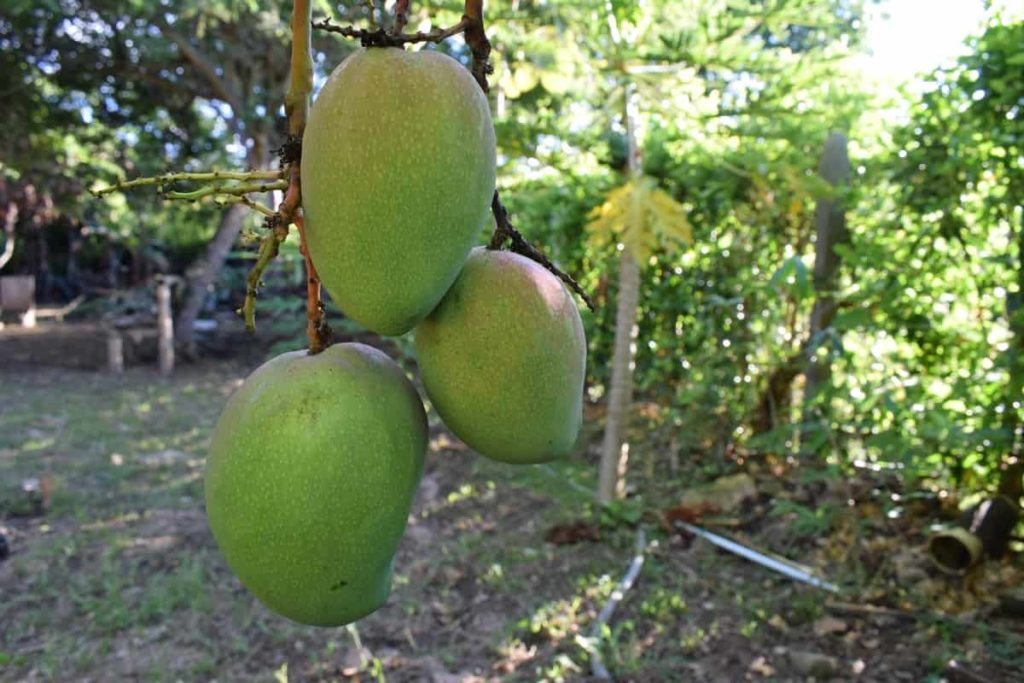
Choosing the best fertilizer for Mango trees is easy if you know the nutritional facts. Many fertilizer brands are available with active ingredients and nutritional values. Fertilizer is essential to your Mango for getting all its required nutrients. When and how you use it is also as important as what fertilizer you use. Many elements are necessary for the growth of Mango trees. Calcium, potassium, boron, and nitrogen are essential nutrients.
Nitrogen is needed for chlorophyll and sugar production. Boron is responsible for cell growth and sugar production. Potassium is the best fertilizer for Mango trees. High levels of potassium assure you of large fruit production. You can encourage your Mango trees to grow large fruits by applying essential nutrients. Potassium should be used for both young trees as well as fruit-bearing trees.
Fertilizer management in Mango
Homemade fertilizers for Mango
Epsom salt
If your soil is magnesium deficient, give Mango trees at least one annual dose of magnesium for maximum fruit flavor. Add 450 grams to 1 kg of Epsom salt in 100 square feet of soil every year.
Coffee grounds
Spread a nearly half-inch layer of coffee grounds around the tree’s base and mix them in the soil using a garden rank. Mix 70 kg vermicompost, 5 kg castor cake, 10 kg neem cake, 5 kg poultry manure, 15 kg wood ash, and spread around the base of the Mango tree. Dolomite and agricultural lime (calcium), and boron (sodium borate) can be lightly sprinkled on the plant’s dripline and applied to the soil.
In case you miss this: Mango Gardening For Beginners – How To Start, FAQs
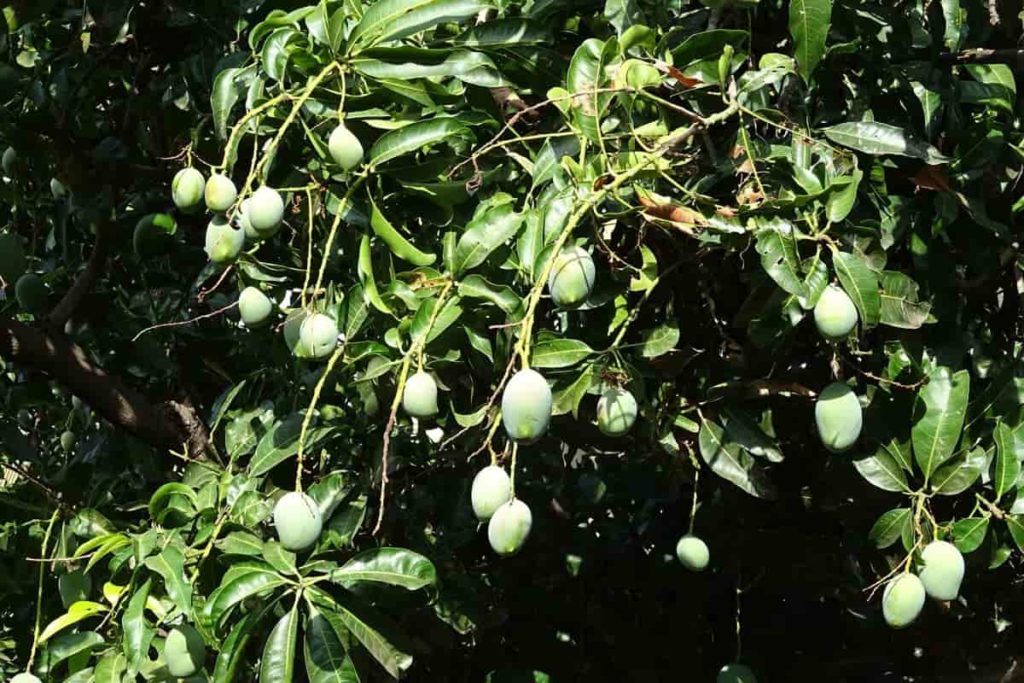
Compost manure for Mango
Cow manure
When the cow manure is fermented correctly, it is an excellent source of nutrients for the Mango tree. It will help in creating healthy growth and growing flowers. You should spread about 10 kg of composted cow manure two weeks before you give them chemical fertilizer around the dripline of mature Mango trees.
Vermicompost
Vermicompost is a nutrient-rich fertilizer used as fertilizer or compost. Vermicompost is a great way to help make your Mango tree healthy to produce lots of sweet, delicious fruits. These organic fertilizer materials are also suitable for your garden.
Liquid fertilizers for Mango
- Mix one tablespoon of kelp powder, one tablespoon of rock phosphate, one tablespoon compost tea, and one tablespoon of fish emulsion in a gallon of water. Stir well, then use about 1/4 to 1/2 gallon of this mixture for a plant every week or two weeks.
- Fallen Mango leaves make good food for compost worms that produce worm castings, a form of organic manure. Later you can use these castings by diluting them with water and applying it to your Mango tree.
- Liquid kelp is not only an organic source of micronutrients but also contains high levels of potassium.
- Applying diluted liquid seaweed fertilizer on Mango tree leaves provides micronutrients needed. Micronutrient elements plants are required in different quantities and according to soil varieties. Mango benefits from magnesium, zinc, and manganese, such as liquid seaweed are supplied by fertilizers.
Natural fertilizers for Mango
When you add compost to the soil, Mango trees perform well. Mango trees also benefit from a ring of mulch (grass clippings, straw) several inches deep, spread around their dripline, about four feet from the trunk, but never touch it.
In case you miss this: Growing Mango Tree In Backyard – A Beginners Guide
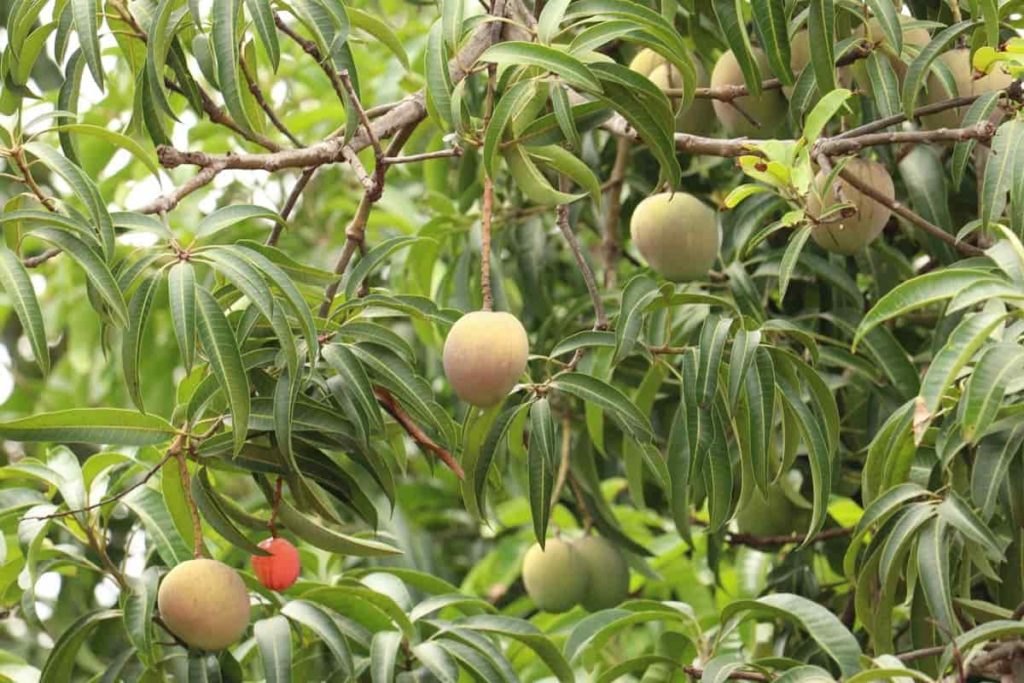
Organic fertilizers for Mango
Potassium sources such as kelp meal, green sand, and granite meal are also good sources of trace minerals like iron. If phosphorus is deficient in the soil, add 2 kg rock phosphate or bone meal. You can also use guano, blood or bone meal, and seaweed or potassium sulfate to provide potassium.
Commercial fertilizers for Mango
Mango tree seedlings need 1-1-1 NPK fertilizer. It shows the ratio of nitrogen and phosphorus, and potassium, respectively. So, if your NPK ratio is 10-10-10 fertilizer: it contains 10% nitrogen, 10% phosphorus and 10% potassium. A mature tree will not require additional nitrogen. When this happens, you can switch to focusing on a mixture with higher phosphorus and potassium ratio and less nitrogen (10-20-20).
Ammonium sulfate
During the first three years of life, use ammonium sulfate-based fertilizer on your Mango tree, four times every year, at the same interval. After the tree is over three years of age, fertilize it four times every year with 600 grams of nitrogen, phosphorus, and potassium divided into equal doses.
Chelated Iron
Give micronutrients, especially iron, to Mango trees three to four times every year by mid-summer.
Mango fertilizer schedule
The number of fertilizers shows the ratio of the weight of the primary nutrients of plants nitrogen, phosphorus, and potassium. This ratio is expressed in the number of packages, such as 10-10-10. Slowly released fertilizers are coated with polymer or sulfur, which takes 8 to 12 weeks to dissolve in the soil. Soluble quick-release fertilizers are generally less expensive than soluble slow-release fertilizers that enter the ground immediately with water. A complete fertilizer contains all N, P, K, chelated iron, and other minerals.
In case you miss this: Mango Seed Germination, Process, Time, Temperature
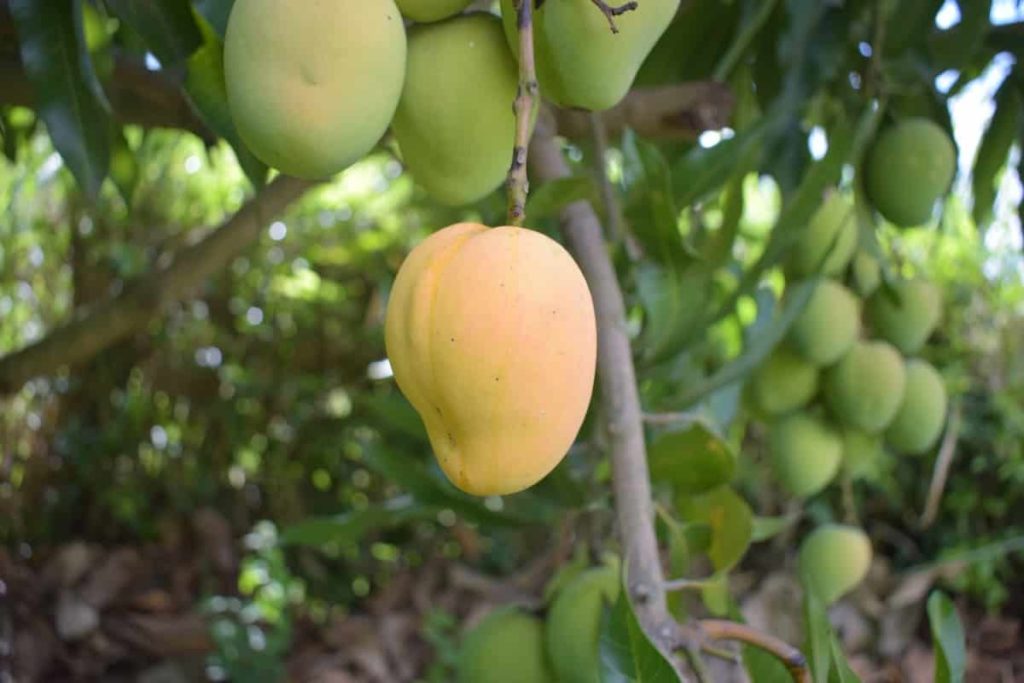
When you first plant trees, mix a super-phosphate fertilizer with soil to encourage strong root growth. When the tree grows, apply 450 to 900 grams of nitrogen (10-20-20) in the first year and during its second and third years 680 grams to 1 kg of the same fertilizer, divided into three or four applications. Spread fertilizer around the tree dripline and spread the water thoroughly later. Be careful not to over-apply fertilizer on young trees.
For every inch of trunk diameter 4 to 5 feet above the ground, apply 450 grams of complete, slow-release fertilizer annually. Half of the same fertilizer is applied before flowering, not during flowers, and after the rest of the Mangoes are harvested. Additional quick-release fertilizers containing nitrogen are used just before the Mango tree flower to encourage the production of flowers and Mangoes.
It would help if you fed established Mango trees three times a year by sprinkling 113 grams around the dropline of small trees – spring, summer, and fall, slowly increasing to 450 grams a year of the tree’s age. Mulch both young and established trees with compost to provide regular but low doses of nitrogen for healthy growth. After spreading fertilizer, it is better to give water to draw nutrients below the soil level. Nutrients do not work very well sitting on top of the soil, and they need to go further down. Plants absorb nutrients with their roots, so fertilizer should reach your plant root system.
Resume the watering schedule regularly after applying fertilizer. Without excess water, liquid fertilizer can reach the root system. If you are using liquid fertilizer, it will filter into the soil on its own without the help of water. Use this liquid fertilizer for Mango trees to save time on watering. After applying your liquid fertilizer, just water your Mango on its regular schedule.
Adding fertilizers during drought and high heat hours causes plant injury and death. Mango trees try to conserve energy during stress periods, but when fertilizer is available, plants try to grow. By excessive fertilization, young plants are also damaged. High levels of nitrogen burn soft roots. Planting trees with fertilizer in the planting hole is not recommended. If fertilizer is added during planting, add 50/50 or less mixture to the soil before filling the planting hole.
How to fertilize Mango in pots
Mango trees are heavy feeders and should be fertilized once a month, during the growing season in the first year. One hundred thirteen grams of organic fertilizer mixture should be spread around the outer half-circle of the pot, avoiding contact with the trunk. Synthetic fertilizer should be avoided with high NPK analysis, as its strength can burn the tree. After the first year, the fertilizer should be applied three times per growing season.
In case you miss this: Growing Mango Tree in Containers from Seed
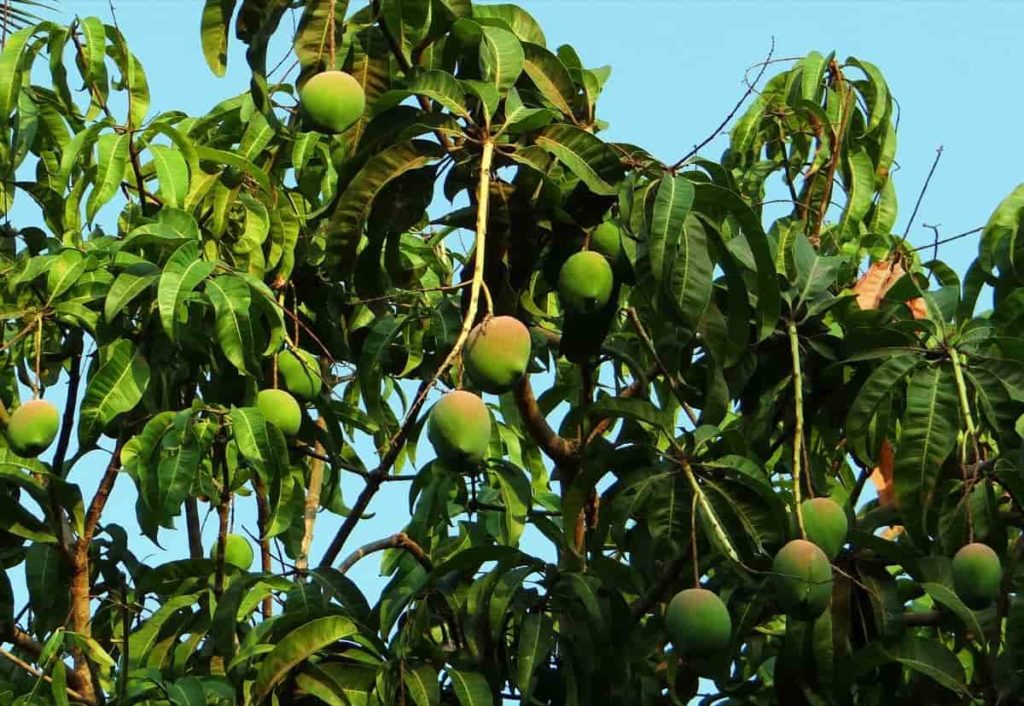
As the tree grows every year, the application rate can gradually increase per application. Fertilizers rich in nitrogen, phosphorus, and potassium grow Mango plants. Maintain a ratio of 6-6-6 for young plants and 10-10-10 for mature plants. Make sure you don’t apply too much fertilizer to young plants.
Frequently asked questions about fertilizers for Mango (FAQ)
How to increase the growth of Mango trees?
Water new trees two or three times in the first week, flooding the area around the trunk. Fertilize your tree after new growth begins; give it a high dose of nitrogen to plant per month until fall.
Which fertilizer increases the size of a Mango?
The annual soil application of N, P, and K has significantly increased the number of Mango fruits per plant, fruit weight, production, and quality of fruits.
In case you miss this: Top Miracle Grow Tips for Your Garden Plants: Vegetables, Fruits, Flowers, and Herbs
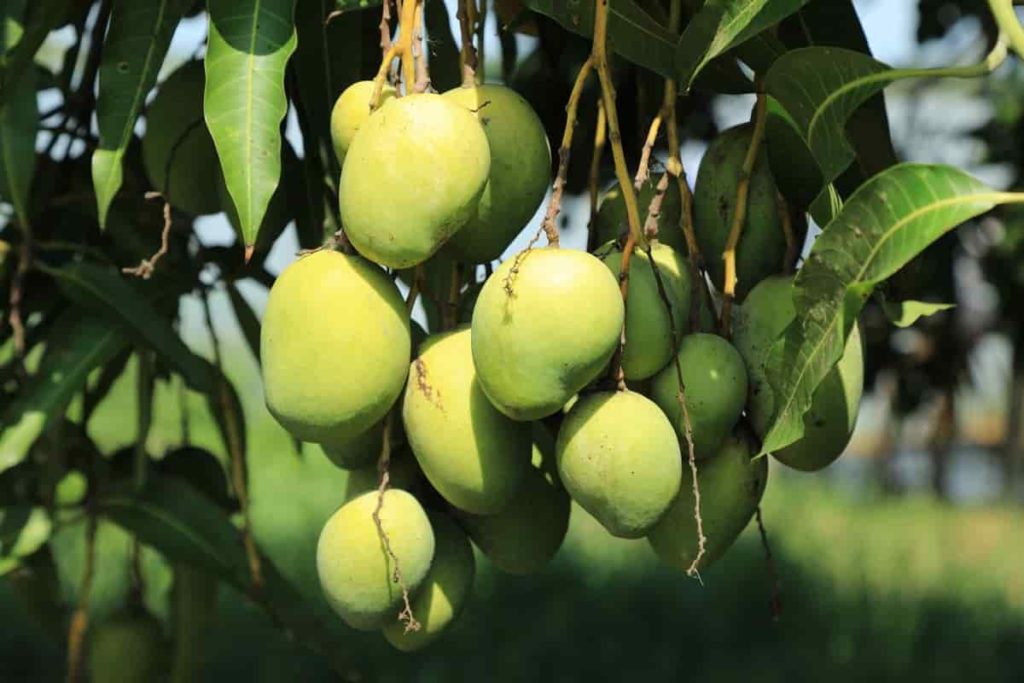
Why are my Mango tree leaves turning yellow?
If the leaves turn yellow first, it can be too much water. It’s always a difficult call, only to check near the roots to see if the plant is wet or dry.
- How to Grow Hibiscus from Flower
- Plantation Ideas for Home Decoration: A Beginners Guide
- Flower Garden Designs and Layouts for Beginners
- Planting and Spacing Techniques in Papaya: A Beginner’s Guide
- Growing Gold: Essential Techniques for Planting Pineapples
- How to Make Kalanchoe Plant Bushy: Home Remedies and Solutions
- 11 Reasons Why Your Gardenia is Not Blooming: Home Remedies and Solutions
- Eco Elegance: The Guide to Designing a Drought-Tolerant Landscape
- Gardening on a Slope: Strategies for Hillside Landscaping
- Nourish and Flourish: Top Organic Mulches for Thriving House Plants
- Everything You Want to Know about Indian Mogra Flower: Discover Uses and Growing
- Green Thumb Success: Expert Tips for Cultivating Greenhouse Pumpkins All Year Round
- Maximize Growth & Flavor: The Ultimate Guide to Companion Planting in Herb Gardens
- How to Control Rhododendron Problems Naturally: Home Remedies and Organic Ways to Fix Them
- Natural Magic: The Remarkable Benefits of Cinnamon for Plants
- Best Steps to Revive Dying Tulip with Natural and Organic Treatment
- 10 Reasons Why Your Angel Trumpet is Not Blooming: Remedies and Treatment
- How to Fix Periwinkle Leaf and Flower-Related Problems: Natural Remedies and Solutions
- How to Fix Zinnias Leaf and Flower Problems: Discover Natural and Home Remedies
- Organic Steps to Induce Lemon Tree Flowers: A Comprehensive Guide
- Bloom Booster: Crafting the Perfect Homemade Bougainvillea Fertilizer
- Optimizing Growth: A Guide to Applying NPK Fertilizer for Potted Plants
- 10 Best Homemade Fertilizers for Rubber Plant: DIY Recipes and Application Method
- How to Boost Female Pumpkin Flowers: Effective Steps for More Flowers and High Yields
- Transform Your Indoor Garden: Top Benefits of Pink Salt for Houseplants
- 10 Best Homemade Fertilizers for Peacock Plants (Calathea): Easy DIY Guide
- Unlock Blooms: 9 Reasons Why Your Potted Chrysanthemum is Not Blooming
- 8 Reasons Why Your Potted Hibiscus is Not Blooming: Fix it with Simple Solutions
- Unlock Blooms: 9 Key Reasons Your Potted Frangipani Won’t Flower
- 10 Reasons Why Is My Ice Plant Not Blooming: Remedies and Treatment
- 10 Reasons Why My Potted Hydrangea Not Blooming: Treatment and Remedies
- 10 Reasons Why is My Wisteria Not Blooming: Remedies and Treatment
- 10 Reasons Why is My Goldfish Plant Not Blooming: Remedies and Treatment
- Maximize Your Space: Ultimate Guide to Balcony Gardening with Grow Bags
- 10 Reasons Why Your Iris is Not Blooming: Remedies and Treatment
- 10 Reasons Why Your Anthurium Plant is Not Blooming: Treatment and Remedies
What are the Side effects of chemical fertilizer in Mango Plant and Soil